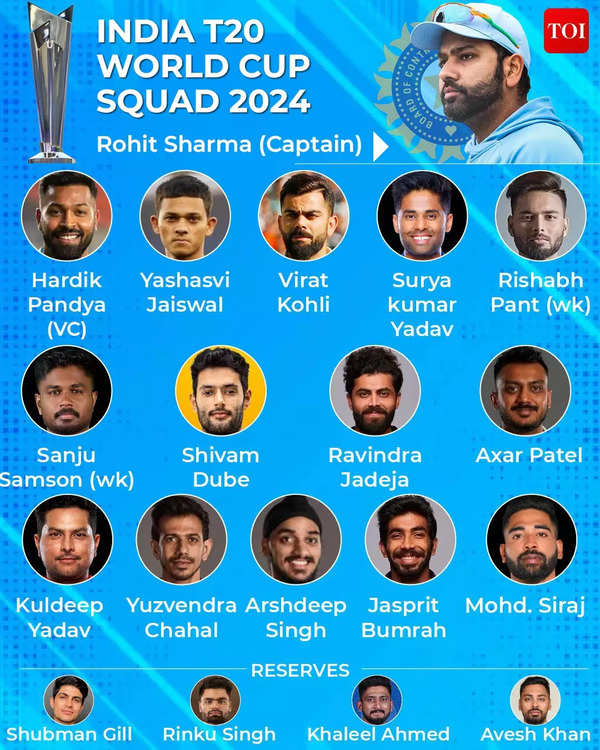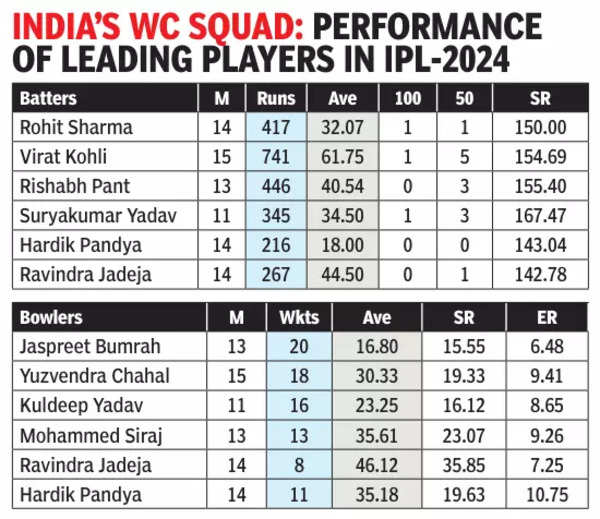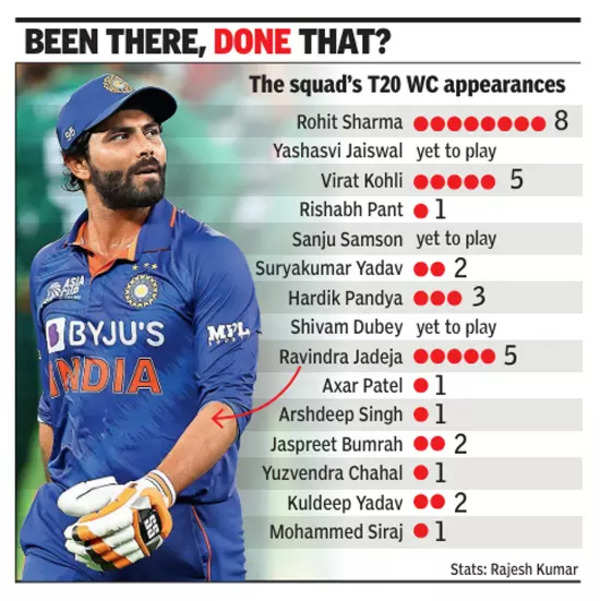The IPL’s overbearing presence can often mask the
T20 World Cup
’s unique imprint on the format. The IPL is at once allencompassing in its scope and specific in its requirements, so India’s selectors chose to be influenced only to an extent by performances in the league.
The Ajit Agarkar-led committee has been both pragmatic and conservative while picking the 15-member World Cup squad.
Naturally, this has somewhat dampened the excitement and anticipation around the younger crop of players who sizzled in this season’s IPL.
ALSO SEE: T20 World Cup Schedule
Where’s Abhishek Sharma? Where’s Harshit Rana? Why Axar Patel over Varun Chakravarthy? Why have no Indian players from both IPL finalists been picked in the World Cup squad? And why does Rinku Singh, a proven finisher, find a place only among the reserves?
It will be interesting to watch whether this safety-first selection approach pays off for Rohit Sharma’s team. It’s relatively easy to poke the weak spots in any IPL team but the T20 World Cup has been a fluid and unpredictable beast.

Even the best teams have not enjoyed eras of World Cup domination, unlike in the 50-over format. The T20 World Cup format also makes it easy for the likes of India to reach the knockouts, so nothing less than a title win will be deemed satisfactory.
When fates can hinge on a single hitor a no-ball, it’s human nature to bet on experience and pedigree. One can say the selectors have been guided as much by gut feel as data. In effect, this T20 World Cup is a farewell fling at an elusive ICC trophy for some senior cricketers who came so close to attaining that goal last year in
the 50-over format.
It’s worth remembering that India have not won a T20 World Cup since the IPL first took off. There are hopes the trend can be broken this time, even with virtually the same crop of top-order players — barring Yashasvi Jaiswal — who faltered in the semifinal against England in Adelaide in 2022.

The nagging feeling remains that in a short format, which lends itself readily to experimentation, shouldn’t this season’s IPL performances have counted for more? Should India have banked on in-form youngsters like they did back in the inaugural edition in 2007, when they won the tournament for the only time?
It’s worth mentioning that T20 was in its infancy in 2007. The seniors had voluntarily opted out. Analysts still hadn’t run over every possible match-up in forensic detail. The T20 key now is the ability to reinforce experience with the ability to reinvent oneself, as Virat Kohli demonstrated in this IPL.

The winning captain in 2007, MS Dhoni, was the first to red-flag the temptation to pick cricketers purely on immediate IPL form. During the 2009 Champions Trophy in South Africa, Dhoni had said such form must be put in “correct perspective”.
Although Dhoni was talking about format-hopping selection choices back then, the ideology doesn’t seem to have changed 15 years on.
“We decided on the core of the team long before the IPL,” captain Rohit Sharma said this time. “In IPL, performances change every day. Anyone will come and score a hundred or take five wickets. We knew 70%-80% of our squad (before the IPL).”
So even though Kohli has remapped his T20 batting, taken on the spinners and lost none of his incredible consistency while striking at 154.69 in this IPL, Agarkar suggested his name had been pencilled in long before.
“We haven’t even been discussing Kohli’s strike rate. You take positives from what is happening in the IPL (but) the pressure of a World Cup is different. You need experience,” Agarkar said.
The pitches in the West Indies are different, slower. Unlike in the IPL, there won’t be just range-hitting at play in this World Cup. That doesn’t mean IPL performances haven’t mattered — just look at the impact Shivam Dube has had with his ability to clobber the spinners in the middle overs, answering India’s call for just such a requirement.
Of course, pedigree is no guarantee of success. India’s squad is packed with proven performers but the same bunch has also tended to falter at the doorstep of an ICC trophy in the past.
Also, India’s selections have been a bit random in the 28 T20Is they have played since the last T20 World Cup. That tournament was supposed to draw a line in the sand and mark a move on from the stalwarts. However, after trying out all and sundry — none of whom got a decent run — that transition process has now been abruptly halted.
Having rejected any recency-bias in selection, Rohit and coach Dravid must now address some key issues: Should Kohli open, like he does in the IPL? Should the twin leg-spin attack be the norm on Caribbean pitches? Can Hardik Pandya and Ravindra Jadeja find form? Will the Dube ploy work? Will Jasprit Bumrah lack pace support? And how do they cover up for Rinku’s absence?
India’s performance in this tournament will not only reveal if this conservative approach was justified, but also shape future selection policies. By the end of it all, we’ll know if recent form — specifically of the IPL kind — should matter more in a T20 World Cup.









 English (US) ·
English (US) ·